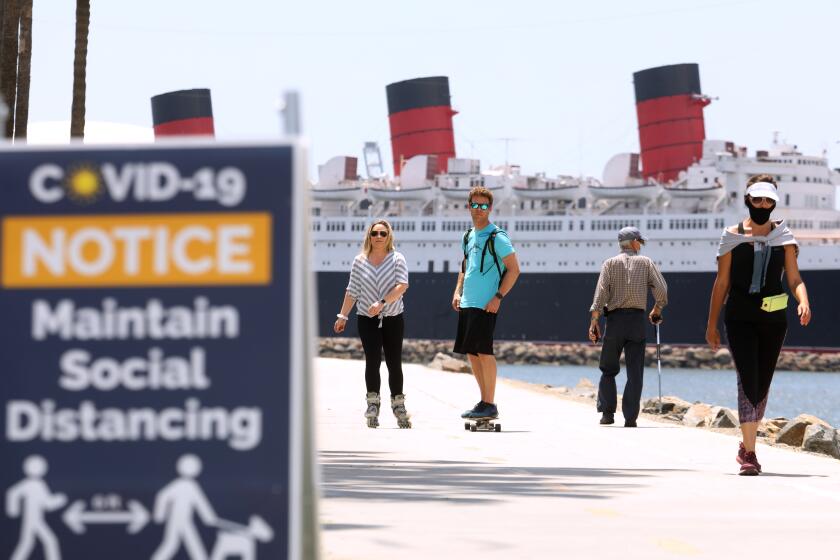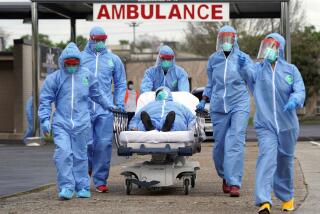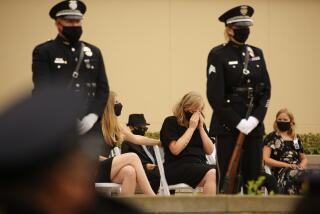Coronavirus deaths pass 100,000 globally
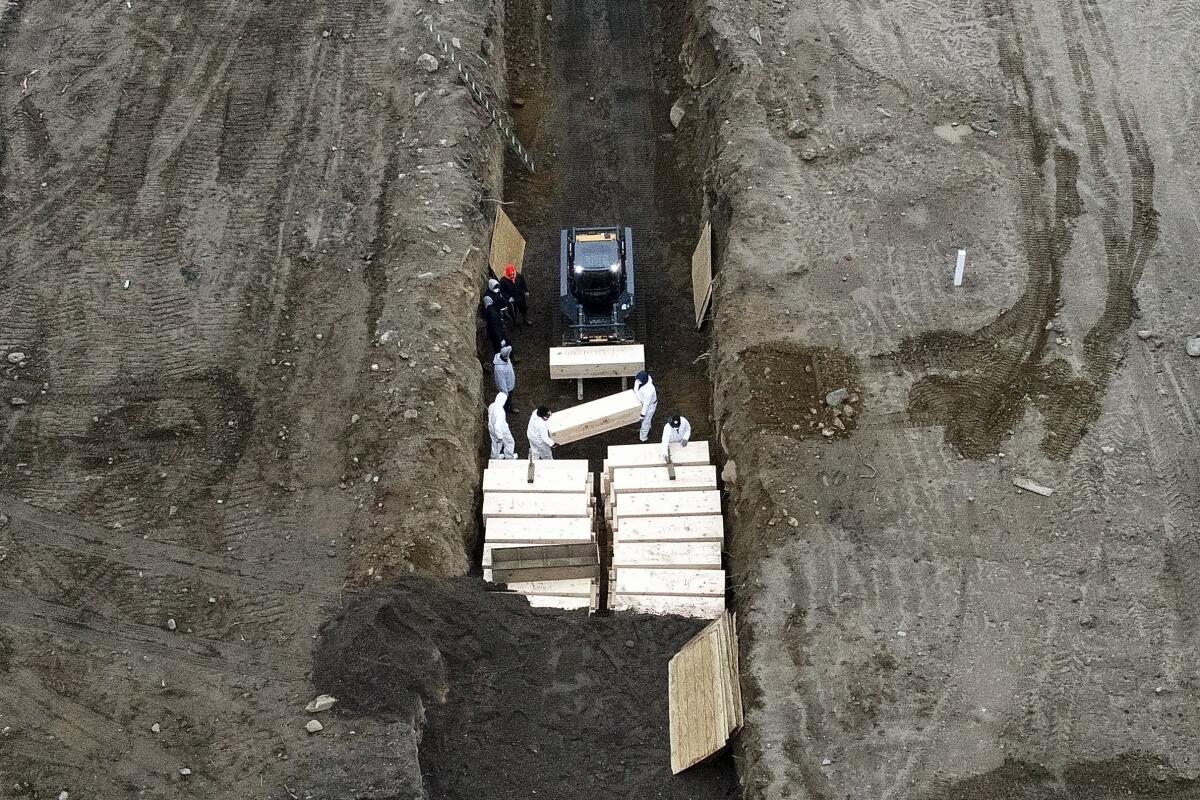
As the worldwide COVID-19 death toll topped 100,000, the U.S. was on the brink of surpassing Italy as the nation with the most fatalities.
- Share via
In a grim global milestone, the worldwide death toll from the COVID-19 pandemic passed the 100,000 mark on Friday, with the United States on the brink of surpassing Italy as the nation with the highest number of fatalities.
Worldwide, the number of confirmed deaths hit nearly 103,000 by Friday afternoon, according to a count maintained by Johns Hopkins University. The true death toll, however, is probably much higher, considering the handicaps of limited testing, different rules for counting the dead and incomplete reporting by some governments.
The coronavirus has laid siege to healthcare systems, battered economies, emboldened nationalist leaders, exposed the intricacies and potential perils of an interconnected world and served as a reminder, like the plagues and natural disasters of past ages, of how vulnerable the planet is to mercurial unseen dangers.
Since December, when health officials first identified the virus in Wuhan, the sprawling capital of China’s Hubei province, the deadly virus has quickly skipped to other Asian countries, where governments sought to limit its impact by imposing strict testing requirements, frequent temperature checks and social distancing measures. The efforts were successful in slowing the spread locally, but the virus had also begun stealthily hopscotching around the globe, with particularly devastating consequences in Italy, Spain and Iran.
In Iran, so many victims died suddenly that Islamic end-of-life rituals were sometimes abandoned in place of mass burial pits, and in northern Italy doctors said they were making life-and-death rationing decisions unheard of outside of times of war.
In the U.S., leaders in some states, including Washington and California, took early, strong steps to implement social distancing even as President Trump continued to downplay concerns about the deadliness of the virus. Limited supplies and coordination on the federal level have since left hospitals to scramble for ventilators, test kits, masks and other vital supplies, and in New York, the epicenter of the nation’s outbreak, emergency rooms have quickly filled toward surge capacity.
Meanwhile, the hardest days, experts warn, appear to remain ahead.
“This virus is moving with speed and velocity across the globe and it’s not going to let up for some time,” said Michael Mina, a professor of epidemiology at Harvard University, who emphasized that, given the nearly certain undercount, the 100,000-death threshold was actually met several days ago.
“There will be darker days,” he predicted, “especially in underdeveloped parts of the world.”
On Friday, the U.S. death toll stood at about 18,600, just behind Italy’s roughly 18,900, according to Johns Hopkins University. It was new deaths in the United States that pushed the worldwide death toll above the 100,000 mark.
In New York, Gov. Andrew Cuomo reported 777 more deaths over the previous 24 hours, bringing the total there to 7,844, far exceeding any other state’s death toll. California’s number of fatalities hovered near 580. Black communities, nursing homes and prisons across the country have been especially devastated by the outbreak.
Trump said Friday he would not move to reopen the country until it’s safe, but announced he’s forming an “Opening our Country” task force focused on the economy.
“I want to get it open as soon as possible,” Trump said during Friday’s daily news briefing at the White House.“The facts are going to determine what I do.”
As the startling scope of the economic devastation comes into sharper focus, the chief of the International Monetary Fund warned that the disease was steering the global economy toward what is sure to be the deepest recession since the Great Depression.
Coronavirus forces changes in Good Friday worship.
The projection by IMF Managing Director Kristalina Georgieva came amid mounting concerns that the virus would soon explode across the world’s poorest nations — where frequent hand-washing and social distancing are often all but impossible — and inevitably return to countries recovering from outbreaks.
A few European and Asian countries have started easing up on stay-at-home orders, which experts say risks a second wave of coronavirus infections that could prolong the global economic meltdown.
The threat of contagion at Good Friday and Easter observances left public health authorities on edge.
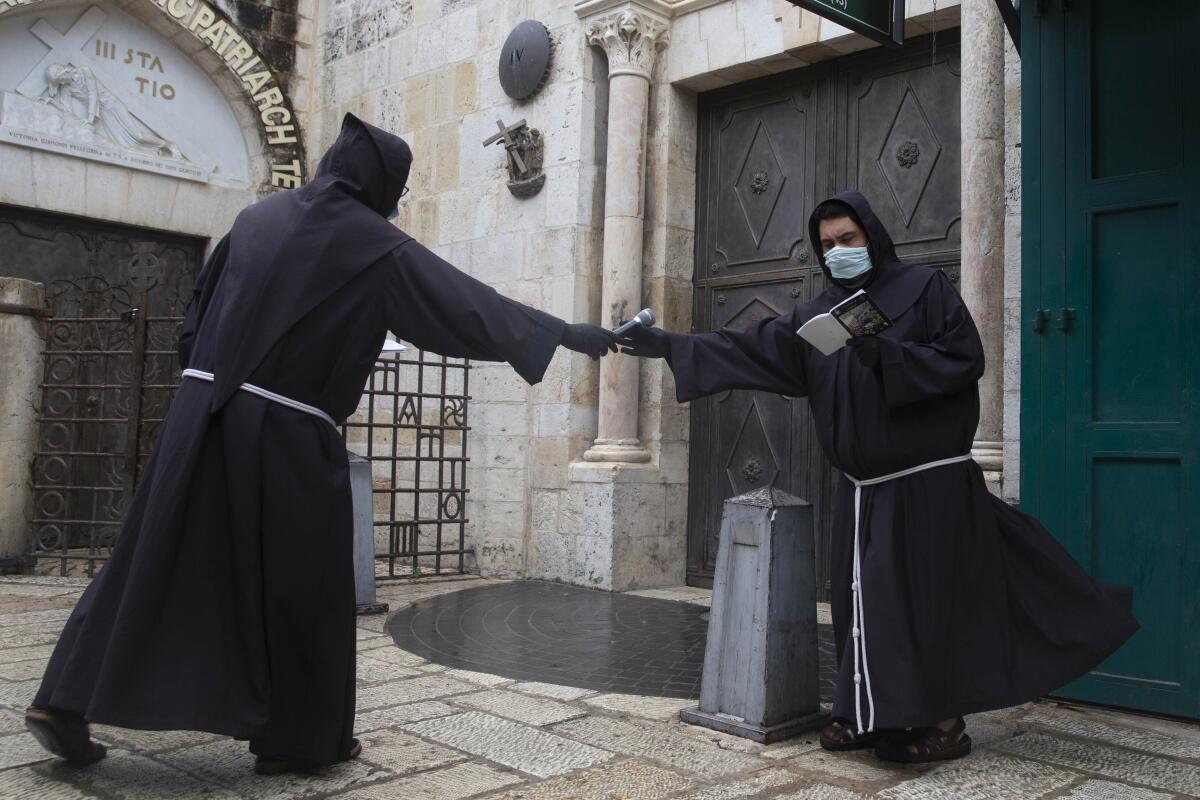
Kansas Gov. Laura Kelly, a Democrat, petitioned the state Supreme Court to stop Republican lawmakers from rescinding her ban on religious gatherings. In Los Angeles, parks that have been partially open for walking and jogging will shut down entirely on Sunday to discourage Easter outings where the virus could spread.
In Italy, helicopters, drones and police patrols have been deployed to keep people in their homes over the holiday weekend. Police issued summonses Thursday to 10,000 people traveling for nonessential reasons. And in Paris, the fire-scarred Notre Dame Cathedral, normally packed on Good Friday, was nearly empty as a French archbishop led a televised Good Friday service.
In Jerusalem, the chanting of a small group of clerics inside the Church of the Holy Sepulcher echoed faintly through the heavy wooden doors as a few people stopped and knelt outside to pray. The centuries-old church, built on the site where Christians believe Jesus was crucified, buried and rose from the dead, is usually packed.
Later, four monks in brown robes and blue surgical masks prayed at the Stations of the Cross along the Via Dolorosa, the ancient route through the Old City where Jesus is believed to have carried the cross before his execution at the hands of the Romans. It runs past dozens of souvenir shops, cafes and hostels, nearly all of which were closed.
During ordinary times, tens of thousands of pilgrims from around the world retrace Jesus’ steps in the Holy Week leading up to Easter. But this year, flights are grounded and religious sites in the Holy Land are closed as authorities try to prevent the spread of the virus, which has already infected about 1.7 million people worldwide.
The shortage of testing for the virus means that, as with the death toll attributed to COVID-19, there is no doubt about a severe undercount of the total number of cases.
While Latin America has thus far been spared the brunt of the pandemic, there is a widespread expectation throughout the region that the worse is yet to come. Governments from Mexico to Brazil are anticipating virus cases to peak later in April or May.
Slightly fewer than 50,000 confirmed cases of the new coronavirus had been recorded in Mexico, Central America and South America, with about 1,900 fatalities — all much lower than in the United States.
China , meanwhile, has reported about 3,300 deaths and South Korea just over 200, according the Johns Hopkins University tracker.
An increase in new confirmed cases in the last few weeks, however, has shown that the fight against COVID-19 will take much longer than anticipated. Singapore, Vietnam and Japan are among many Asian countries that have had to step up distancing measures, close schools and impose more quarantines.
There’s also growing concern that poorer countries with threadbare health systems such as Cambodia, Laos and Myanmar could be hiding the extent of their outbreaks. Lack of testing in the Philippines and Indonesia are also fueling fears that the death toll is set to rise exponentially.
In Spain, more that 16,000 people have died, and in nearby France the number of dead reached about 13,200. In the United Kingdom, where British Prime Minister Boris Johnson recently left the intensive care unit of a London hospital after being treated for COVID-19, about 9,000 people have died.
Meanwhile, Americans prepared for another weekend of isolation. States including Michigan, with about 1,300 dead, and Louisiana, with more than 750 dead, are bracing to see increased deaths in the weeks ahead.
Back in New York, Gov. Cuomo on Friday called on Trump to invoke the Defense Production Act to take control of production by private laboratories of tests for virus antibodies, saying widespread testing is the key to reopening the economy.
Without federal money and supervision, he said, the private laboratories developing tests in New York don’t have the capacity to produce enough for the millions of people who need them.
“We need a tremendous, mind-boggling increase in volume quickly,” he said. “And I don’t believe just waiting for the private sector companies to come up to scale you’re going to see it in the time frame that you need to get it done.”
Times staff writers Patrick J. McDonnell in Mexico City and David Pierson in Singapore contributed to this report.
With mask-wearing requirements and stronger stay-at-home orders, California is preparing for a weekend of unprecedented restrictions.
More to Read
Sign up for Essential California
The most important California stories and recommendations in your inbox every morning.
You may occasionally receive promotional content from the Los Angeles Times.
